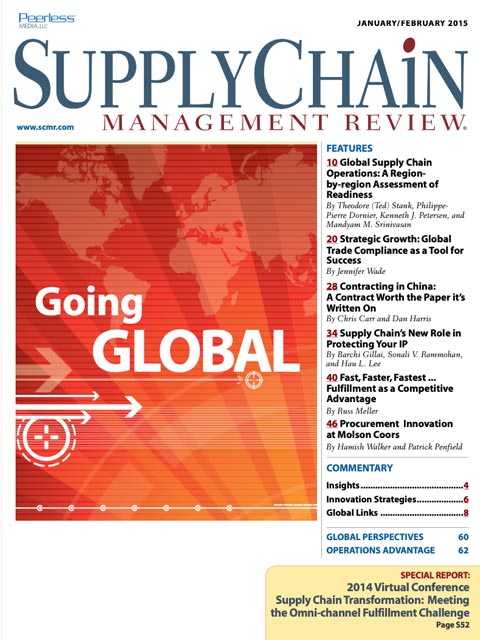Sorry, but your login has failed. Please recheck your login information and resubmit. If your subscription has expired, renew here.
January-February 2015
As long as there have been boats and beasts of burden, intrepid business professionals, governments, and marauders have sought fame, fortune, wealth, and value by going global. Think the Phoenicians, Marco Polo, and the Vikings in days of old. Or in contemporary times, think of China, BRIC, EMEA, and other emerging markets. One could argue that outsourcing to China a few decades ago gave birth to supply chain management as we think of it today. This month we’re including an online bonus column from APQC. While this issue focuses on global management, we didn’t want to miss out on the column. Browse this issue archive.Need Help? Contact customer service 847-559-7581 More options
The last decade or so witnessed an offshoring boom. At the start of the boom, companies decided to outsource their operations internationally to low-cost countries in order to benefit from the economy of scale and scope offered by vendors, to mitigate technological risks and uncertainty, and to improve their focus on retained core competencies.
China became the first choice for international outsourcing of manufacturing. The country was propelled by the devaluation of its currency, a reduction of tariffs from its entrance into the World Trade Organization, generous tax incentives, cheap industrial land, and low labor rates. By becoming the “hot spot” for international manufacturing, China experienced an influx of foreign capital, which not only simulated its economic growth and development but also eroded its costs advantage over the years. China’s increasingly urban population now has higher expectations in terms of wages and working conditions.
A study conducted by The Boston Consulting Group suggests that it is time to “reassess” China and estimates that for some products, the country’s overall cost advantage could disappear in 2015. Additionally according to The Economist, as wage advantages disappear, firms are discovering the disadvantages of distance. The cost of shipping heavy goods halfway around the world has been rising sharply, and goods spend weeks in transit. The magazine also states that companies have found that manufacturing somewhere cheap and far away but keeping research and development at home can have a negative effect on innovation; a succession of wars and natural disasters in the past decade has highlighted the risk that long supply chains might become disrupted.
 |
This complete article is available to subscribers
only. Click on Log In Now at the top of this article for full access. Or, Start your PLUS+ subscription for instant access. |
SC
MR
Sorry, but your login has failed. Please recheck your login information and resubmit. If your subscription has expired, renew here.
January-February 2015
As long as there have been boats and beasts of burden, intrepid business professionals, governments, and marauders have sought fame, fortune, wealth, and value by going global. Think the Phoenicians, Marco Polo, and… Browse this issue archive. Access your online digital edition. Download a PDF file of the January-February 2015 issue.
 |
Download Article PDF |
The last decade or so witnessed an offshoring boom. At the start of the boom, companies decided to outsource their operations internationally to low-cost countries in order to benefit from the economy of scale and scope offered by vendors, to mitigate technological risks and uncertainty, and to improve their focus on retained core competencies.
China became the first choice for international outsourcing of manufacturing. The country was propelled by the devaluation of its currency, a reduction of tariffs from its entrance into the World Trade Organization, generous tax incentives, cheap industrial land, and low labor rates. By becoming the “hot spot” for international manufacturing, China experienced an influx of foreign capital, which not only simulated its economic growth and development but also eroded its costs advantage over the years. China’s increasingly urban population now has higher expectations in terms of wages and working conditions.
A study conducted by The Boston Consulting Group suggests that it is time to “reassess” China and estimates that for some products, the country’s overall cost advantage could disappear in 2015. Additionally according to The Economist, as wage advantages disappear, firms are discovering the disadvantages of distance. The cost of shipping heavy goods halfway around the world has been rising sharply, and goods spend weeks in transit. The magazine also states that companies have found that manufacturing somewhere cheap and far away but keeping research and development at home can have a negative effect on innovation; a succession of wars and natural disasters in the past decade has highlighted the risk that long supply chains might become disrupted.
 |
SUBSCRIBERS: Click here to download PDF of the full article. |
SC
MR

Latest Supply Chain News
- Few executives believe their supply chains can respond quickly to disruptions
- Technology’s role in mending supply chain fragility after recent disruptions
- Tech investments bring revenue increases, survey finds
- Survey reveals strategies for addressing supply chain, logistics labor shortages
- Israel, Ukraine aid package to increase pressure on aerospace and defense supply chains
- More News
Latest Podcast

 Explore
Explore
Latest Supply Chain News
- Few executives believe their supply chains can respond quickly to disruptions
- Technology’s role in mending supply chain fragility after recent disruptions
- Tech investments bring revenue increases, survey finds
- Survey reveals strategies for addressing supply chain, logistics labor shortages
- Israel, Ukraine aid package to increase pressure on aerospace and defense supply chains
- How CPG brands can deliver on supplier diversity promises
- More latest news
Latest Resources

Subscribe

Supply Chain Management Review delivers the best industry content.

Editors’ Picks





